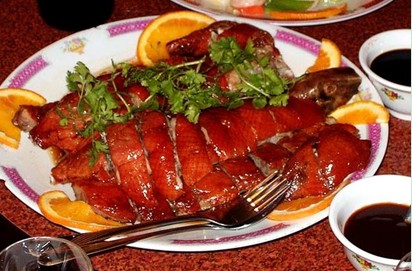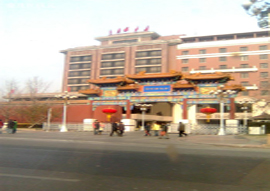Along with the grand view of THE GREAT WALL, China is famous for its delicious and healthy food around the world. Beijing, as a international city and the capital of China, certainly owns the famous food restaurant from all over the world, like Italian food, French food, Japanese food, Korean food, Vietnamese food and so on.
What to eat
As for Beijing famous food, have you ever heard the Lamb Hot Pot (Shuan Yang Rou), Beijing Roast Duck? Here are some introductions of them:
Lamb Hot Pot: It is popular and everyone loves it in Beijing because of its gorgeous taste. Personally, it is my favorite one. So I recommend it strongly for you. When you are in Beijing, this is definitely you don’t want to miss.
Recommended restaurant: Dong Lai Shun
Address: 5th floor, New Dong’an Mansion, Wang Fu Jing Street
Phone: 010-65280932/010-65280501
Beijing Roast Duck: Having a good reputation around the world, Beijing Roast Duck is made of good-quality Beijing Duck. The way to make this dish is divides into two schools, while the most famous roast duck restaurants in Beijing is the represent and combination of the two schools.
 
Where to find it:
Bianyifang Roast Duck Restaurant
Address: A2#, Chongwenmen Outer Rd. Chongwen District, Beijing.
Tel: + 86 10 67120505
Transport: Bus 9, 39 or 60 to Chongwenmen Station
Jiuhuashan Roast Duck Restaurant
Address: 55#, Zeng’guang Rd. Haidian District, Beijing
Tel: +86 10 6848 3481
Transportation: Bus 26, 27 or 709 to Zeng’guangrukouxi Station or Huayuancunxikou Station
Hepingmen Quanjude Roast Duck Restaurant
Address: Building 14, Qianmen West Rd. Xuwu District, Beijing
Tel: +86 10 6302 3062, 010 63036134
Transport: Bus 14, 15, 44, 48 or 808 or Subway Line 1.
Qianmen Quanjude Roast Duck Restaurant
Address: 32#, Qianmen Rd., Chongwen District, Beijing
Tel: +86 10 6511 2418
Transport: Bus 9, 22, 53, 59 or 819 or Subway Line 1 to Qianmen Station
Food Histroy
People also call this the Capital City cuisine. Beijing was the capital city for the Liao, Jin, Yuan, Ming, and Qing  dynasties. Except for the Ming Dynasty, all the rulers of these dynasties were from northern nomadic tribes. For those 500-plus years, the dishes available from Beijing's catering trade were dominated by meat dishes, which corresponded to the eating habits of the ruling class. The Mongolian rulers of the Yuan Dynasty were especially fond of mutton, and 80% of the dishes in their palace were made of mutton. These mutton dishes still are made today, such as stewed mutton, instant-boiled mutton, quick-fried mutton tripe, and fried dumplings with minced mutton. dynasties. Except for the Ming Dynasty, all the rulers of these dynasties were from northern nomadic tribes. For those 500-plus years, the dishes available from Beijing's catering trade were dominated by meat dishes, which corresponded to the eating habits of the ruling class. The Mongolian rulers of the Yuan Dynasty were especially fond of mutton, and 80% of the dishes in their palace were made of mutton. These mutton dishes still are made today, such as stewed mutton, instant-boiled mutton, quick-fried mutton tripe, and fried dumplings with minced mutton.
The Qing Dynasty rulers ate pork before moving to Beijing from Shenyang in northeastern China. Their cooking methods were stewing, roasting, and boiling. Pork and mutton have been equally represented in Beijing cuisine since the Qing Dynasty as a result of the dietetic influence of the Manchus. Roast and stewed pig, pork dishes, and pig's offal stewed in ceramic pots offered by the Shaguoju Restaurant (ceramic pots restaurant) were the first to be offered to suit the eating preferences of the Manchus. Gradually these dishes were accepted by the residents of Beijing.
Beijing was the gathering place of the literati and officials, and many skilled chefs followed these people to Beijing. These chefs brought the different cuisines to the capital and greatly enriched the flavors of Beijing cuisine. The Shandong, Huai-Yang, and Jiangsu-Zhejiang cuisines all strongly influenced Beijing cuisine. Because Shandong was near Beijing, people migrated from there to Beijing to earn their living, and many worked in the catering trade. Shandong cuisine was similar to Beijing cuisine, so its dishes were quickly accepted. The Shandong people almost had a monopoly on the Beijing catering trade during the Qing Dynasty.
People from Shandong opened many famous Beijing restaurants, including the Tongfengtang, Fushoutang, Huifengtang, Guangheju, and Tongheju. The quick-frying techniques of the Shandong cuisine and its use of onions greatly influenced Beijing cuisine. For example, quick-fried mutton, a popular, common dish, is a typical Beijing dish that uses the cooking skills and flavoring methods of the Shandong cuisine. Now, people in Beijing quickly fry onions in hot oil before stir-frying the dish because of the influence of the Shandong cuisine.
As the capital city, Beijing had many cultural and trade exchanged with other parts of the country. Many people came from Huai'an, Yangzhou, southern Jiangsu, and western Zhejiang for business or to seek official posts in Beijing. Literati and officials placed high expectations on restaurant food, and many even created dishes. The chefs in Beijing all boasted of being able to create the dishes of the southern cuisines. Some Beijing residents and businessmen from other areas wanted to eat the dishes of their native cuisines without leaving the city, which stimulated the development of the Huai’an -Yangzhou cuisine in Beijing.
When southern food was introduced in the north, its flavor was changed. For example, Huai'an-Yangzhou cuisine has a sweet and less salty taste, while northern cuisine has salty, rich flavors. Before southern cuisines were accepted in Beijing, they had to adjust their flavors, and dishes had to be created that combined the southern and northern cuisines. For example, Mr. Pan's Fish, a famous dish of quick-fried fish and mutton, was introduced by Pan Zuyin (1830 - 1890), a member of the Qing Dynasty Imperial Academy. Wu's Sliced Fish, invented by Wu Yansheng of Suzhou, was a Beijing dish that had the flavor of Jiangsu-Zhejiang cuisine.
Manchu and Han banquets, which gradually became popular during Emperor Qianlong's reign, included nearly 200 cold dishes and dozens of refreshments and pastries. The main courses were Manchu style roast dishes, shark's fin, edible bird's nest, sea cucumbers, jellyfish, and abalone served southern style. These were supplemented by traditional Manchu pastries and Huai'an Yangzhou or Jiangsu-Zhejiang style dishes that precisely reflected the cooking skills and flavors of Beijing cuisine. Peking duck, which has become a favorite of people outside Beijing and even with foreigners, is prepared using force- fed ducks. The duck is roasted in Huai’an and Yangzhou style to emphasize the color and taste, then seasoned with fermented flour sauce, and eaten with onions and pancakes baked Shandong style. This typical dish reflects the origin of Beijing cuisine.
Beijing cuisine is famous for its hundreds of dishes with special flavors that are unmatched by any other cuisine. Beijing cuisine does not emphasize strangeness or uniqueness, only delicious food made from common ingredients with tastes that are very agreeable. It is China's most typical cuisine. |
